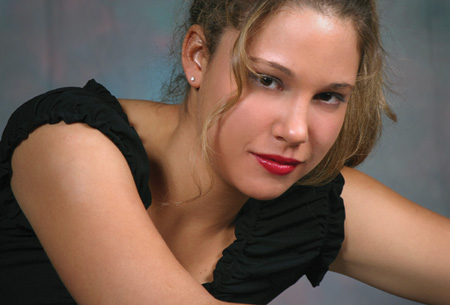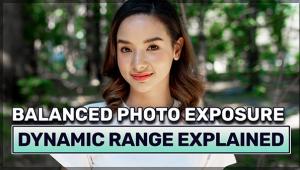Well said, indeed. Nicely explained. I am an amateur to these stuff and this is a pretty nice read. But for now, I have to give more time to my anthropology essays writing project.
Adorama Monolights Page 2

| During the same workshop, I photographed Leslie using two Adorama DigiPoppers. One was placed camera-left set at full power and bounced into a 45" F.J. Westcott Optical White Satin umbrella. The other was mounted on a low stand, behind Leslie, and was used to provide some separation from the background, something a one-light setup did not offer. A Canon EOS D60 at ISO 100 set at f/8 at 1/80 sec with a 28-105mm lens (at 105mm) was used. |
Each metal-shelled Flashpoint II
includes a sturdy reflector that was a good match to the 45" F.J. Westcott
umbrellas I use as well as that company's Halo and Apollo light banks.
Adorama offers several accessories for the Flashpoint II monolights, including
barn doors, snoots, 16" "beauty" reflector, and 24x24"
and 24x36" light banks. The accessories bayonet onto the front of the
Flashpoint II using a Photogenic Photomaster compatible mount, so all your speed
rings that fit that system should work. Be aware that Photogenic's PowerLight
and StudioMax monolights use a different mounting standard.
See the accompanying charts for detailed specifications for both series of monolights.

| Proving
you can make images anywhere, this image was made in my friend John's
garage using a single Adorama Flashpoint II, model 620, holding a 45"
F.J. Westcott Optical White Satin umbrella and placed to the right of
the model. Light from the left was provided by a single photoflood lamp
in a reflector attached to a clamp. A slow shutter speed (1/30 sec)
was used to pick up the ambient light from the different colored light
source and a Canon EOS 10D, using a 28-105mm lens (at 75mm), was set
at ISO 100. The background was created using Flaming Pear's (www.flamingpear.com)
|
In The Field
Both the cute DigiPoppers and Flashpoint II monolights produced output that
was consistent with the data shown in the accompanying charts. Exposure was
measured using the highly accurate, yet clunky, battery-eatin' Gossen
Luna Star F2 meter. Almost all of the time the measured aperture produced well
exposed image files, but occasionally they were tweaked by looking at the histogram
on my Canon digital SLR and making adjustments. On the Flashpoint II monolights
this was accomplished by turning the continuously variable Power Setting knob
on the back of the light. Since the DigiPoppers have only three-power settings
(1/4, 1/2, full), or maybe four if you count "off," I just changed
my camera's aperture to get perfectly exposed images.
Adorama includes everything you need in the package, from reflector to power
cord to flash tube and modeling lights as well as a surprisingly rugged (and
long) 15-foot sync cord. The sync cord plug for the DigiPoppers is mini-audio
so Bowens' (www.rtsphoto.com)
way-cool Pulsar wireless slave units connected perfectly. The Flashpoint II
monolights use the larger 1/4" phone plug, so you'll need to make
a trip to RadioShack to get an adapter if you want to use the Pulsars.
- Log in or register to post comments


Very well explained and I am new to these stuffs. It is a good read. But now I have to continue to my UK essay help for the students.
Regards,
https://www.britishessayshelp.co.uk/

































